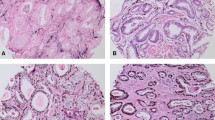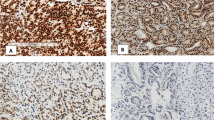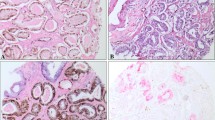Abstract
Purpose
ERG expression has been proposed to signify molecular subtype of PCA. However, its significance in early onset prostate cancer (PCA) is not characterized.
Materials and methods
ERG protein expression was investigated in a cohort of 121 men diagnosed with localized PCA at <50 years of age with a mean follow-up time of 65.7 months. ERG was correlated to patients’ outcome and clinical-pathological parameters using univariate and multivariate analysis.
Results
ERG expression was detected in 76/118 (64.4 %) analyzable patients’ samples and showed interfocal heterogeneity (differences between foci) in 17/118 (14.4 %) patients. There was significant association between ERG expression and Gleason score (p = 0.022), but not with any other clinical-pathologic parameter, including pre-surgical PSA levels, tumor volume, pathological stage, surgical margin or lymph-vascular invasion. ERG had significant effect on the rate of biochemical relapse following radical prostatectomy, with ERG positive patients showing higher relapse rates vs. ERG negative patients (p = 0.007). However, considering time till biochemical relapse post-radical prostatectomy, ERG expression showed positive insignificant trends (p = 0.071). Notably, and of great significance, in this cohort of early onset disease, none of the ERG negative PCA patients exhibited biochemical relapse.
Conclusion
The study results suggest that ERG expression may be of added prognostic value in localized prostate cancer in patients with early onset PCA. However, the issue of ERG interfocal heterogeneity observed may require the evaluation of several tumor foci to assess ERG status per case. Incorporating ERG status into existing nomograms may be of added prognostic value in patients with early onset PCA.




Similar content being viewed by others
References
Siegel R, Naishadham D, Jemal A. Cancer statistics. CA Cancer J Clin. 2012;62(1):10–29. doi:10.3322/caac.20138.
Grönberg H. Prostate cancer epidemiology. Lancet. 2003;361(9360):859–64. doi:10.1016/S0140-6736(03)12713-4.
Weischenfeldt J, Simon R, Feuerbach L, Schlangen K, Weichenhan D, Minner S, et al. Integrative genomic analyses reveal an androgen-driven somatic alteration landscape in early-onset prostate cancer. Cancer Cell. 2013;23(2):159–70. doi:10.1016/j.ccr.2013.01.002.
Lin DW, Porter M, Montgomery B. Treatment and survival outcomes in young men diagnosed with prostate cancer: a population-based cohort study. Cancer. 2009;115(13):2863–71. doi:10.1002/cncr.24324.
Kotsis SV, Spencer SL, Peyser PA, Montie JE, Cooney KA. Early onset prostate cancer: predictors of clinical grade. J Urol. 2002;167(4):1659–63.
Obek C, Lai S, Sadek S, Civantos F, Soloway MS. Age as a prognostic factor for disease recurrence after radical prostatectomy. Urology. 1999;54(3):533–8.
Ryan CJ, Elkin EP, Cowan J, Carroll PR. Initial treatment patterns and outcome of contemporary prostate cancer patients with bone metastases at initial presentation: data from CaPSURE. Cancer. 2007;110(1):81–6. doi:10.1002/cncr.22736.
Briganti A, Spahn M, Joniau S, Gontero P, Bianchi M, Kneitz B, et al. Impact of age and comorbidities on long-term survival of patients with high-risk prostate cancer treated with radical prostatectomy: a multi-institutional competing-risks analysis. Eur Urol. 2013;63(4):693–701. doi:10.1016/j.eururo.2012.08.054.
Schaefer G, Mosquera JM, Ramoner R, Park K, Romanel A, Steiner E, et al. Distinct ERG rearrangement prevalence in prostate cancer: higher frequency in young age and in low PSA prostate cancer. Prostate Cancer Prostatic Dis. 2013;16(2):132–8. doi:10.1038/pcan.2013.4.
Tomlins SA, Rhodes DR, Perner S, Dhanasekaran SM, Mehra R, Sun XW, et al. Recurrent fusion of TMPRSS2 and ETS transcription factor genes in prostate cancer. Science. 2005;310(5748):644–8.
Soller MJ, Isaksson M, Elfving P, Soller W, Lundgren R, Panagopoulos I. Confirmation of the high frequency of the TMPRSS2/ERG fusion gene in prostate cancer. Genes Chromosom Cancer. 2006;45(7):717–9. doi:10.1002/gcc.20329.
Hermans KG, van der Korput HA, van Marion R, van de Wijngaart DJ, Ziel-van der Made A, Dits NF et al. Truncated ETV1, fused to novel tissue-specific genes, and full-length ETV1 in prostate cancer. Cancer Res. 2008;68(18):7541–7549. doi:10.1158/0008-5472.CAN-07-5930.
FitzGerald LM, Agalliu I, Johnson K, Miller MA, Kwon EM, Hurtado-Coll A, et al. Association of TMPRSS2-ERG gene fusion with clinical characteristics and outcomes: results from a population-based study of prostate cancer. BMC Cancer. 2008;8:230. doi:10.1186/1471-2407-8-230.
Hessels D, Smit FP, Verhaegh GW, Witjes JA, Cornel EB, Schalken JA. Detection of TMPRSS2-ERG fusion transcripts and prostate cancer antigen 3 in urinary sediments may improve diagnosis of prostate cancer. Clin Cancer Res. 2007;13(17):5103–8.
Demichelis F, Fall K, Perner S, Andren O, Schmidt F, Setlur SR, et al. TMPRSS2:ERG gene fusion associated with lethal prostate cancer in a watchful waiting cohort. Oncogene. 2007;26(31):4596–9. doi:10.1038/sj.onc.1210237.
Liu S, Yoshimoto M, Trpkov K, Duan Q, Firszt M, Corcos J, et al. Detection of ERG gene rearrangements and PTEN deletions in unsuspected prostate cancer of the transition zone. Cancer Biol Ther. 2011;11(6):562–6.
Teng LH, Wang C, Begin LR, Dolph M, Yilmaz A, Trpkov K, et al. ERG protein expression and gene rearrangements are present at lower rates in metastatic and locally advanced castration-resistant prostate cancer compared to localized disease. Urology. 2013;82(2):394–9. doi:10.1016/j.urology.2013.03.029.
Braun M, Goltz D, Shaikhibrahim Z, Vogel W, Bohm D, Scheble V et al. ERG protein expression and genomic rearrangement status in primary and metastatic prostate cancer–a comparative study of two monoclonal antibodies. Prostate Cancer Prostatic Dis. 2012;15(2):165–9. doi:10.1038/pcan.2011.67.
Reid AH, Attard G, Ambroisine L, Fisher G, Kovacs G, Brewer D et al. Molecular characterisation of ERG, ETV1 and PTEN gene loci identifies patients at low and high risk of death from prostate cancer. Br J Cancer 2010;102(4):678–84.
Nam RK, Sugar L, Yang W, Srivastava S, Klotz LH, Yang LY, et al. Expression of the TMPRSS2:ERG fusion gene predicts cancer recurrence after surgery for localised prostate cancer. Br J Cancer. 2007;97(12):1690–5.
Saramaki OR, Harjula AE, Martikainen PM, Vessella RL, Tammela TL, Visakorpi T. TMPRSS2:ERG fusion identifies a subgroup of prostate cancers with a favorable prognosis. Clin Cancer Res. 2008;14(11):3395–400.
Perner S, Mosquera JM, Demichelis F, Hofer MD, Paris PL, Simko J, et al. TMPRSS2-ERG fusion prostate cancer: an early molecular event associated with invasion. Am J Surg Pathol. 2007;31(6):882–8. doi:10.1097/01.pas.0000213424.38503.aa00000478-200706000-00008.
Saramaki OR, Harjula AE, Martikainen PM, Vessella RL, Tammela TL, Visakorpi T. TMPRSS2:ERG fusion identifies a subgroup of prostate cancers with a favorable prognosis. Clin Cancer Res. 2008;14(11):3395–400. doi:10.1158/1078-0432.CCR-07-2051.
Yoshimoto M, Joshua AM, Cunha IW, Coudry RA, Fonseca FP, Ludkovski O et al. Absence of TMPRSS2:ERG fusions and PTEN losses in prostate cancer is associated with a favorable outcome. Mod Pathol. 2008;21(12):1451–60.
Darnel AD, Lafargue CJ, Vollmer RT, Corcos J, Bismar TA. TMPRSS2-ERG fusion is frequently observed in Gleason pattern 3 prostate cancer in a Canadian cohort. Cancer Biol Ther. 2009;8(2):125–30 (pii:7134).
Gopalan A, Leversha MA, Satagopan JM, Zhou Q, Al-Ahmadie HA, Fine SW, et al. TMPRSS2-ERG gene fusion is not associated with outcome in patients treated by prostatectomy. Cancer Res. 2009;69(4):1400–6. doi:10.1158/0008-5472.CAN-08-2467.
Attard G, de Bono JS, Clark J, Cooper CS. Studies of TMPRSS2-ERG gene fusions in diagnostic trans-rectal prostate biopsies. Clin Cancer Res. 2010;16(4):1340. doi:10.1158/1078-0432.CCR-09-2253.
Bismar TA, Dolph M, Teng LH, Liu S, Donnelly B. ERG protein expression reflects hormonal treatment response and is associated with Gleason score and prostate cancer specific mortality. Eur J Cancer. 2012;48(4):538–46. doi:10.1016/j.ejca.2012.01.001.
Epstein JI, Allsbrook WC Jr, Amin MB, Egevad LL. The 2005 International Society of Urological Pathology (ISUP) Consensus Conference on Gleason Grading of Prostatic Carcinoma. Am J Surg Pathol. 2005;29(9):1228–42.
Barry M, Perner S, Demichelis F, Rubin MA. TMPRSS2-ERG fusion heterogeneity in multifocal prostate cancer: clinical and biologic implications. Urology. 2007;70(4):630–3. doi:10.1016/j.urology.2007.08.032.
Acknowledgments
The authors would like to thank Shuhong Liu for technical support and Samar Hegazy for scientific input. This work was supported by the Young Investigator Award of the Prostate Cancer Foundation, USA, Prostate Cancer Canada, and is proudly funded by the Movember foundation, Grant #B-2013-01. The work was also supported by internal grant from Calgary Laboratory Services (RS09-530).
Conflict of interest
The authors have no conflict of interest to declare in this study.
Author information
Authors and Affiliations
Corresponding author
Rights and permissions
About this article
Cite this article
Huang, KC., Dolph, M., Donnelly, B. et al. ERG expression is associated with increased risk of biochemical relapse following radical prostatectomy in early onset prostate cancer. Clin Transl Oncol 16, 973–979 (2014). https://doi.org/10.1007/s12094-014-1182-x
Received:
Accepted:
Published:
Issue Date:
DOI: https://doi.org/10.1007/s12094-014-1182-x




